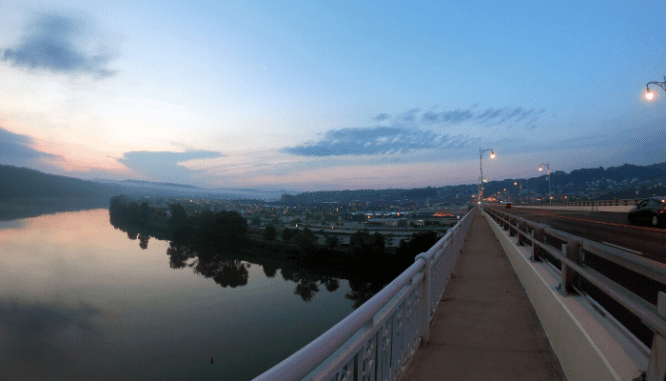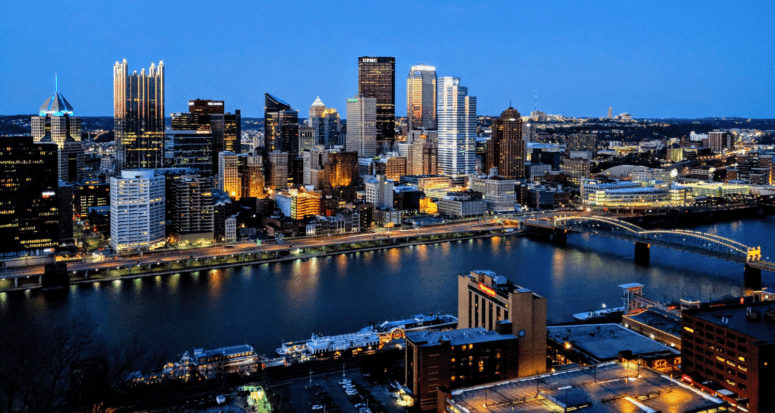Getting Your Home for a Steel: Everything You Need to Know about Buying a House in Pittsburgh
- Published on
- 4 min read
-
 Kim Upstill Contributing AuthorClose
Kim Upstill Contributing AuthorClose Kim Upstill Contributing Author
Kim Upstill Contributing AuthorKim enjoys using her experience as an interior design consultant, picky renter and tiny home builder to help buyers and sellers deep dive into their next dream home project. Kim is currently based in Chicago IL where, when she is not going to open houses or admiring the architectural wonders of the city, she can be found at home avoiding the weather with tea and a good book.
Once the steel capital of America, known for its stunning mixture of bridges and brick, Pittsburgh is now emerging as a vibrant hub of culture, education, and technology.
With the recent tech boom bringing in jobs and spurring new developments, houses in desirable neighborhoods often sell in a matter of days, or even hours.
When considering buying in Pittsburgh, you’ll also need to consider the icy winters and humid summers — meaning your home’s age, location, and physical accessibility should be top priorities. The romantic, industrial brick facades of the city come with a downside: 66% of homes were built before 1960. In a quick-to-sell market, this means that time-sensitive tests for issues like lead paint (recommended for all houses built before 1978), radon, and mold can eat into a buyer’s schedule and budget.
We spoke to Dan Haeck, a top-rated agent who has sold houses in Pittsburgh for over 13 years, who says that finding the right agent and knowing a few basic ground rules of homebuying in Pittsburgh can assure that you get the full picture of each home you’re looking at. Before you know which house you want, you’ll need to know where and when to buy: for this article, we’ve gone deep, researching neighborhoods, looking at seasonal price shifts, and talking to industry professionals to compile this comprehensive guide of how to find and buy your perfect home in Pittsburgh.

Price, price, price
Though considered much more affordable than many major cities (rating a 2 out of 10 on the Kiplinger affordability index), the cost of buying a home in Pittsburgh rose a record 5.9% in 2018. The median price of homes listed on Zillow in 2020 for Pittsburgh was $220,000, while the median selling price of homes was $163,700. However, the price of buying a house in Pittsburgh will vary hugely depending on where you want to buy and whether you’re looking at an older home, a condo, or at investing in a new build.
What kind of houses can you expect to find in Pittsburgh?
Though known for its industrial brick facades, the wide range of neighborhoods in Pittsburgh means a wide range of house options. From Cape Cods to condos, we’ve researched a few basic styles that can get you started out the gate thinking about what type of home is right for you!
Older builds: Cape Cod, Victorian, and row houses
With 66% of homes built before 1960, and 42% built before 1940, there are plenty of style options to choose from in Pittsburgh if you have your heart set on an older home.
According to Haeck, Cape Cod styles are some of the more perennially popular homes in Pittsburgh — a look created by Puritan settlers based on the design of the traditional English cottage, Cape Cod houses typically have steep, sloped roofs (great for not collecting snow!), brick facades, and simple exterior ornamentation. Found in neighborhoods all over the city, this style is quintessentially Pittsburgh, with row houses and Victorian homes coming in as close runners-up.
Heather Visnesky, owner at Abode, who has been staging homes in Pittsburgh for the last six years, says Scandinavian and mid-century modern are popular design trends that help stagers marry the new appliances of a remodeled kitchen with the antique charm of an original fireplace.
Visnesky also warned that potential buyers should enquire about the age of municipal plumbing in the neighborhoods where they’re looking. While remodeled homes will most likely have new pipes, the local water lines that feed the house could still contain traces of lead. Her suggestion? Get professional tests done, and have a reverse osmosis tap installed to ensure cleaner, clearer drinking water in older homes.
Condos
Over the past 10 years, condo development has rapidly accelerated in Pittsburgh. Partly in response to an increasing demand from tech sector workers, there are now a number of neighborhoods with condo options for buyers — especially downtown, where housing was once in limited supply.
Buying a condo can be a great way to get your feet into the real estate market without worrying about surprise exterior maintenance costs. With the rough winters Pittsburgh experiences, not worrying about roofs and gutters can be a weight off a new homeowner’s mind. Many condos in Pittsburgh are remodels of older structures, which means you can still enjoy the big windows, natural lights, and — you guessed it — brick facades Pittsburgh has to offer without the potential pitfalls of older homes.
New construction
Haeck has noticed many young homebuyers are more worried about the potential health risks of older buildings (mold, radon, lead) than their predecessors. Because of the cost in both time and money to access these risks, Haeck says many buyers in Pittsburgh are opting for new construction.
Although “not everyone is into the cookie-cutter aesthetic,” if you’re interested in going that route, you can get a non-custom build for around $100 to $120 per square foot, or an all-brick home with customizable flood plan options for around $150 to $175 a square foot.
Haeck does warn that the devil is in the details — if you’re considering a new build, don’t assume you have to work with the agent who shows you around the model home: you don’t. Buyers should choose the agent they want to work with for a new build as carefully as they choose the design of their new home to ensure avoiding hidden fees and agendas.

Knowing your neighbor: Where to live in Pittsburgh
Pittsburgh is convenient for walking and biking, comprising an incredible number of small neighborhoods — each with their own street fairs, food festivals (like this one entirely dedicated to pickles), and neighborhood pride. Ranked No. 8 on Livability’s list of best places to live in 2019, Pittsburgh is home to more than 60 colleges and universities, with 42.9% of residents holding a bachelor’s degree or higher, according to the 2019 census.
The paradox of choice rules much of our lives, and Pittsburgh is no exception! With hundreds of small, distinct neighborhoods to choose from, how do you find the perfect one for you?
We’ve considered some basic factors that can help you home in on parts of the city that will cater to your tastes and have offered a selection of neighborhoods to get you started:
Outdoor-indoor lifestyles
Are you someone who thrives on access to parks and culture? Do you like running or biking away from busy streets, but still value urban amenities and a cozy home to return to after a day spent out in the world? You might be interested in…
Regent Square
Bordering Frick Park, Pittsburgh’s largest park at 600 acres, this neighborhood boasts galleries, a lively cafe scene, and a welcoming vibe. If you want a city feel and access to the outdoors this neighborhood might be right for you! Bonus points: contemplate the brevity of life at nearby Homewood Cemetery, which has local walking tours and contains “beautiful mausoleums and fascinating monuments.”
Highland Park
A need for a municipal water system in the 1800s created what is today Pittsburgh’s Highland Park regional park. With popular walking trails — including a reservoir loop trail, a local favorite — Highland Park neighborhood next door to the park offers an urban feel with excellent amenities. Niche.com gives this area great ratings on nightlife, safety, and diversity, and with the Highland Jazz festival in the summer and the Pittsburgh Zoo within walking distance, this neighborhood has a great mix of outdoor opportunities and cultural presence.
Artsy and hip
You’ve moved to the city to live your best life, and that means world-class dining, great dance parties, easy access to gyms, and some contemplative urban strolls along those famous bridges. You want to be able to walk to it all and come back to your nest buzzing with energy. You might be looking for…
Mexican War Streets
Artistic and young, homebuyers can expect to find vibrant row houses and local watering holes like the Monterey Pub and Rigg’s Lounge. One of the main attractions of the Mexican War Streets area is the Mattress Factory — an artist residence and site-specific performance space.
Downtown
More hip than artsy, but with a cultural scene that will keep you constantly buzzing, downtown offers a slew of bars, restaurants, nightlife, small parks, and big coffee shops. Rated the No. 1 neighborhood for young professionals to live by Niche, Downtown offers a vibrant urban atmosphere that is young, liberal, and more ethnically diverse than many Pittsburgh neighborhoods.
Quiet, and with trees
You’re looking to create a home that isn’t in the heart of the activity, but not too far away from it, either. You like being able to walk to a nice dinner, but also want a quiet neighborhood where you and your family (fur or human) can feel at ease.
Friendship
A tree-lined neighborhood of old Victorian homes, Friendship is an oasis of calm at the intersection of three excellent neighborhoods known for their cultural activities: Shadyside, Bloomfield, and East Liberty. This means you’ll get great walking options for restaurants and shopping, and an easy retreat away from the excitement to recharge.
Mt. Lebanon
The 108-year-old planned community of Mt. Lebanon will wow you with its historic homes and calm atmosphere. Though it’s a suburb, this neighborhood has a T stop, the Pittsburgh Light Rail system that can whisk you into the city. There are seven elementary schools and no buses, which means children safely walk home from school on the small leafy streets of this ’burb, and the ahead-of-its-time planning of the community’s layout means curving lanes and sweeping views are in store for residents.

When to buy
Because Pittsburgh experiences what locals affectionately refer to as “the seasons,” buying at the right time in Pittsburgh can save you a surprising amount of money.
The worst time to buy if you’re on a tight budget is June. With the summer weather and longer days, houses sell for an estimated 10.56% more than the yearly average. However, there are also more buyers in the summer, which means more listings: if you are more interested in variety than finding the lowest price possible, summer can be the perfect time to look.
Are you willing to brave a little winter weather to increase your savings? February brings prices that are lower than the yearly average by 13%. The added bonus of shopping in the cold months is that seeing houses in more challenging weather makes buyers more realistic about what they need in a home.
Finding a top buyer’s agent in Pittsburgh
In 2019, HomeLight’s top agents helped homebuyers save, on average, $46,396, and facilitated 1.8 times the number of transactions compared to the average Pittsburgh agent. In January 2020, the city of Pittsburgh increased its property transfer tax to a whopping 5% on all sales (compared to Philadelphia’s 3.2%), which means finding a great agent to help you buy the perfect home the first time around is more valuable than ever.
With a housing market as diverse and neighborhood-specific as Pittsburgh, you want a highly qualified buyer’s agent to help guide you through the process. Working with HomeLight ensures you meet the best professionals in the area to help you find the Pittsburgh home that’s just right for you.
Make sure it’s a steel! Schedule a meeting with one of our buyer agents today and take the first step towards owning your dream home in the beautiful city of Pittsburgh!
Header Image Source: (Igor Oliyarnik / Unsplash)
